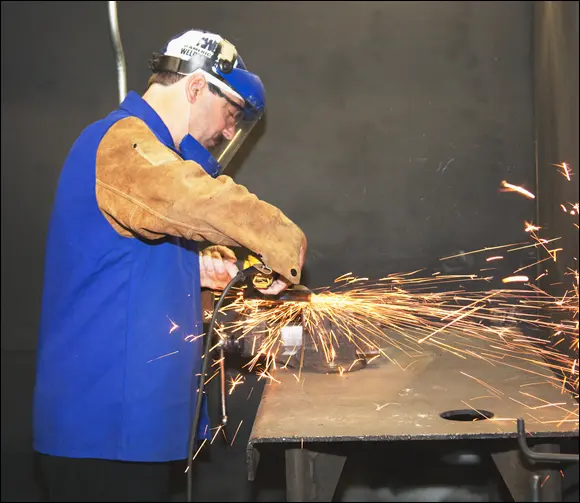1 ...6 7 8 10 11 12 ...16 Strength: How much external force the metal can take without breaking.
Ductility: The ability to change shape without breaking.
Magnetism: Some metals (like steel) are magnetic; others (like aluminum) aren’t.
Hardness: The resistance of a metal to being damaged when another metal is applied to it.
Resistance to oxidization: When metals combine with oxygen, they become oxidized. That’s what causes steel to rust, for example. Some metals — tungsten, for instance — are very resistant to oxidization.
Electrical conductivity: Some metals conduct electricity much more efficiently than others. For example, silver is an incredible conductor of electricity, but stainless steel doesn’t conduct well at all.
Melting point: Every metal has a melting point — the temperature at which the metal turns from a solid to a liquid. This property is critical in welding because, of course, you’re trying to melt metal. Tungsten has the highest melting point; you need temperatures of 6,170 degrees Fahrenheit to melt tungsten. That’s remarkably high compared to, say, tin, with a melting point of only 450 degrees Fahrenheit.
 For more great information on steel, check out the American Iron and Steel Institute’s website at
For more great information on steel, check out the American Iron and Steel Institute’s website at www.steel.org .
Preparing steel for welding
All metals have to be cleaned and prepared before you weld them, and steel is definitely no exception. Quality welds aren’t going to happen if your steel is covered with surface contaminants. And some of those contaminants can be downright dangerous to your health if they’re heated up and converted to fumes while you’re welding. (Flip to Chapter 3to read all about the safety gear you can get to protect yourself from fumes.)
You especially need to do your best to remove rust from the surface of your steel. Rust is especially common on mild steel (covered earlier in this chapter), and it can wreak havoc when you’re trying to produce a high quality weld. The most common defect you experience as a result of rust is porosity (the presence of lots of little holes) in your welds, and porosity can really ruin a good weld joint.
 If you want to use a steel that’s less prone to rusting, try one that has a little chromium added to it. Chromium slows down corrosion processes in steel. You can also try weathered steel, which has a copper alloy in it and holds up well outdoors.
If you want to use a steel that’s less prone to rusting, try one that has a little chromium added to it. Chromium slows down corrosion processes in steel. You can also try weathered steel, which has a copper alloy in it and holds up well outdoors.
You can use one of two methods for cleaning your steel prior to welding: chemical or mechanical. The method you choose depends on the metal type, the condition of the metal, the welding process you’re planning to use, and the equipment available.
 Don’t assume that a piece of steel (or any metal for that matter) is clean just because it looks clean. Even a new piece of steel fresh from your welding supply store has contaminants on the surface that you need to clean off prior to welding.
Don’t assume that a piece of steel (or any metal for that matter) is clean just because it looks clean. Even a new piece of steel fresh from your welding supply store has contaminants on the surface that you need to clean off prior to welding.
Cleaning steel with mechanical methods
When you clean your steel mechanically, you clean the surface by scraping, brushing, or grinding. I usually clean pieces of steel by hand (without power tools) only when the pieces are very small because power tools are just faster otherwise. If you opt to clean steel by hand, I recommend using a very sturdy wire brush. (Check out Chapter 4for information on wire brushes and other basic tools you need for welding.)
 When cleaning a metal before welding, make sure that the metal in your wire brush or the metal on the attachment you plan to use on your power tool is the same as the metal you’re going to weld. For example, if you’re going to be cleaning a piece of steel, make sure you use a steel wire brush or grinder, not one made of brass or another metal. Otherwise, you run the risk of contaminating the metal with another metal. The exception? It’s okay to use a stainless steel wire brush on aluminum.
When cleaning a metal before welding, make sure that the metal in your wire brush or the metal on the attachment you plan to use on your power tool is the same as the metal you’re going to weld. For example, if you’re going to be cleaning a piece of steel, make sure you use a steel wire brush or grinder, not one made of brass or another metal. Otherwise, you run the risk of contaminating the metal with another metal. The exception? It’s okay to use a stainless steel wire brush on aluminum.
Tools powered by electricity or pressurized air have become the standard for cleaning steel in many welding shops, especially for shops that weld large pieces. The most common power tools used for cleaning steel are angle grinders, shown in Figure 2-2. An angle grinder in use is depicted in Figure 2-3.

FIGURE 2-2:A typical angle grinder.
 You may think that you can ease up a little on your safety precautions when you’re cleaning a piece of metal but not yet welding it, but don’t be fooled. You can be injured during the cleaning process, particularly if you’re using power tools to clean the metal. Head to Chapter 3for the lowdown on safety.
You may think that you can ease up a little on your safety precautions when you’re cleaning a piece of metal but not yet welding it, but don’t be fooled. You can be injured during the cleaning process, particularly if you’re using power tools to clean the metal. Head to Chapter 3for the lowdown on safety.
Cleaning steel with chemicals
Chemical cleaning is, as you can probably guess, a way to clean steel by using harsh chemicals. I’m talking about some pretty rough chemicals here, so if you go the chemical cleaning route, please be sure to treat the materials with the utmost respect.

FIGURE 2-3:Cleaning steel with an angle grinder.
 The chemicals used to clean steel before welding are caustic and extremely dangerous. They can do serious damage to your eyes and skin. Before using any of these chemicals, be sure you’ve read and understand the Material Safety Data Sheets (MSDS) that lay out their risks. Pay special attention to the ways in which you combine these chemicals because many of them react violently if you mix them up.
The chemicals used to clean steel before welding are caustic and extremely dangerous. They can do serious damage to your eyes and skin. Before using any of these chemicals, be sure you’ve read and understand the Material Safety Data Sheets (MSDS) that lay out their risks. Pay special attention to the ways in which you combine these chemicals because many of them react violently if you mix them up.
You can clean steel with several different chemicals, and here are a few that you may want to consider.
 Almost all the solvents used to clean steel and other metals before welding are extremely flammable, so be sure that no spark or flame ever comes in contact with the solvent or its fumes. If you clean steel with one of these solvents, make sure the metal is completely dry and the solvent has evaporated or dissipated before you begin welding. Also, be sure to keep your solvent containers in a safe place away from your welding area, as I note in Chapter 3.
Almost all the solvents used to clean steel and other metals before welding are extremely flammable, so be sure that no spark or flame ever comes in contact with the solvent or its fumes. If you clean steel with one of these solvents, make sure the metal is completely dry and the solvent has evaporated or dissipated before you begin welding. Also, be sure to keep your solvent containers in a safe place away from your welding area, as I note in Chapter 3.
Acetone: This harsh chemical removes rust and oxidation from steel. Welders usually use acetone by spraying it on and rubbing or wiping it off with a clean rag. Compared to some of the other solvents sometimes used to clean metal, acetone is relatively mild, but it’s still a toxic material, so proceed with caution.
Alcohol: You can use alcohol for light cleaning and for degreasing. I recommend spraying it on and wiping it off with a clean rag or cloth.
Acid: You can use sulfuric or hydrochloric acids to remove rust scales and oxidation from steel before welding it. These substances are dangerous, so use extreme caution if you go this route — in fact, I recommend cleaning with acid only as a last resort. After applying the acid, make sure you rinse the area thoroughly with hot water and dry it as soon as possible.
Читать дальше

 For more great information on steel, check out the American Iron and Steel Institute’s website at
For more great information on steel, check out the American Iron and Steel Institute’s website at  Don’t assume that a piece of steel (or any metal for that matter) is clean just because it looks clean. Even a new piece of steel fresh from your welding supply store has contaminants on the surface that you need to clean off prior to welding.
Don’t assume that a piece of steel (or any metal for that matter) is clean just because it looks clean. Even a new piece of steel fresh from your welding supply store has contaminants on the surface that you need to clean off prior to welding.
 You may think that you can ease up a little on your safety precautions when you’re cleaning a piece of metal but not yet welding it, but don’t be fooled. You can be injured during the cleaning process, particularly if you’re using power tools to clean the metal. Head to Chapter 3for the lowdown on safety.
You may think that you can ease up a little on your safety precautions when you’re cleaning a piece of metal but not yet welding it, but don’t be fooled. You can be injured during the cleaning process, particularly if you’re using power tools to clean the metal. Head to Chapter 3for the lowdown on safety.











